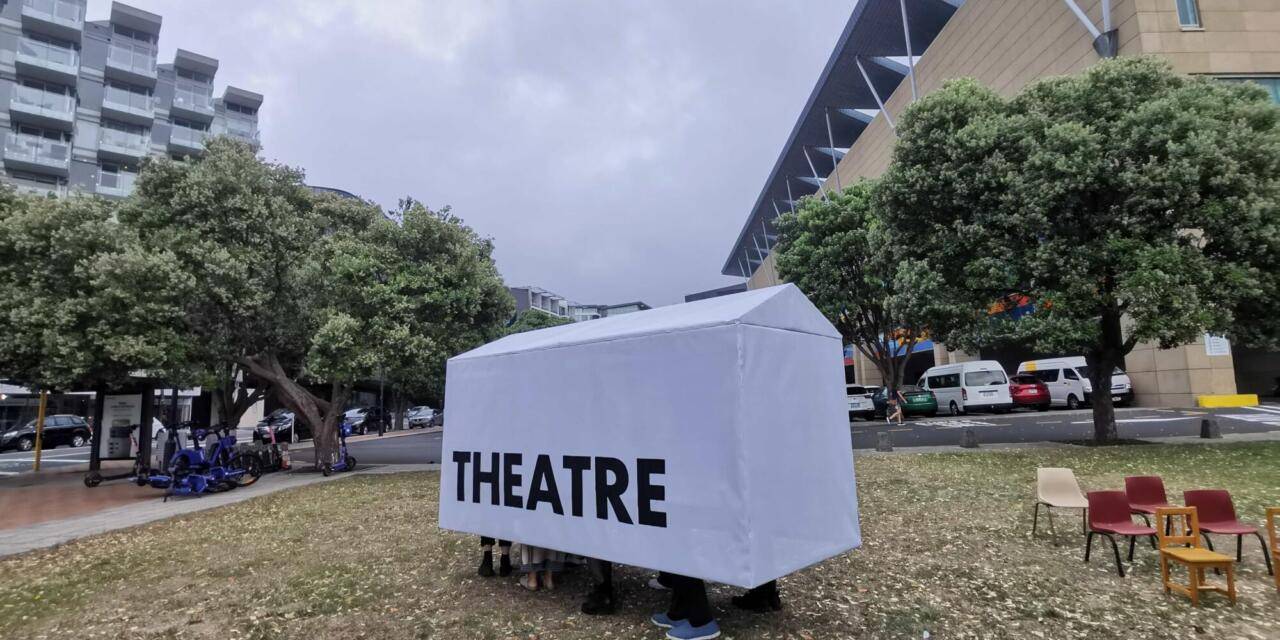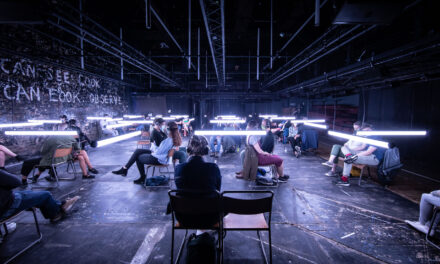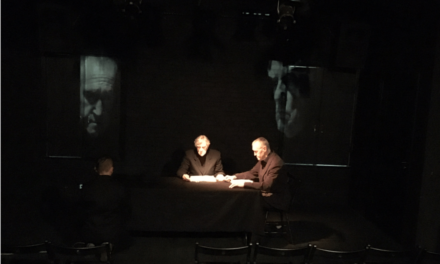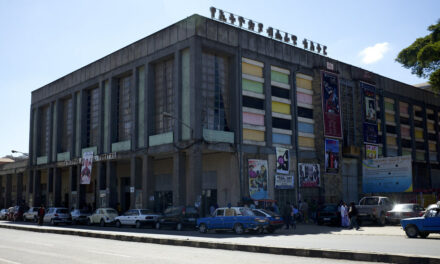The Drifting Room, created and performed by Stephen Bain. The Performance Arcade 2024, Te-Whanganui-A-Tara Wellington waterfront, 22-25 February 2024.
What if the theatre—that fixed architectural space that transforms and conjures up a multitude of imaginary spaces—could drift off its foundations and explore the world beyond? This and many other questions are addressed by Stephen Bain’s playfully subversive The Drifting Room. Over several decades of festival and theatre-going, I’ve attended a multitude of immersive promenade shows, audio tours, and site-specific works, but for me, The Drifting Room was a uniquely pleasurable and stimulating experience that opened up fresh ways of thinking about performance and the city. Stephen Bain, who trained as an architect at Victoria University of Wellington, as an actor at Toi Whakaari: New Zealand Drama School, and who has a doctorate from the University of Tasmania focusing on performance in public spaces, is one of Aotearoa’s most inventive performance makers.[1]
In Te-Whanganui-a-Tara/Wellington, The Drifting Room was performed as part of The Performance Arcade, an annual performance festival on the waterfront, now in its 14th year.[2] The festival takes place in an array of shipping containers, each fitted out with a temporary installation or performance. The Performance Arcade was created by Sam Trubridge, who teaches performance design and scenography at Toi Whakaari, and whose PhD Pelagic States: Beyond Nomadic and Oceanic Practices (Massey University 2018) examines concepts of liquidity and performance. The Performance Arcade is located on a wharf facing Wellington Harbour, in between the vast national museum, Te Papa Tongarewa, and a marina containing dozens of expensive yachts.
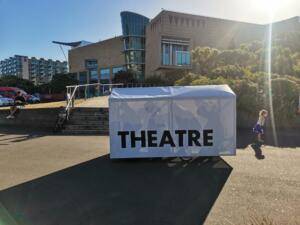
The Drifting Room passes the national museum, Te Papa Tongarewa in Te Whanganui-a-Tara Wellington. Photo courtesy of Stephen Bain.
The Drifting Room is a small, lightweight structure with a gabled roof and the word “Theatre” printed in block letters on each side. The theatre is clad in white billboard fabric, which creates a sort of two-way mirror effect, solid on the outside, and transparent from the inside, meaning that we can see what’s going on outside, but passers-by cannot see in. The whiteness perhaps symbolizes that what we’re about to experience is the opposite of black-box theatre.
At the performance, there are six of us, including two American tourists who are eating their lunch. The structure sits between the shipping containers and the water. It’s a beautiful sunny day, drawing Wellingtonians out to enjoy the holiday atmosphere on the waterfront. We stoop to enter the tiny space and are seated in miniature chairs set out in rows facing the entrance. Stephen welcomes us to “Wellington’s smallest theatre” and briefs us on the journey we’re about to undertake. Stephen is gentle and informal, so I imagine that even the most reluctant participant would feel at ease. But our group is full of enthusiasm and before we get going, one participant mentions Baudelaire’s concept of the flâneur—that mythical urban observer who strolls the boulevards and arcades of great cities.
Then we stand, each take hold of a rail on either side of the structure, and lift gently. The theatre begins to move. Stephen teaches us a variety of movement strategies. Walking forward is the most basic, but we can also do a much more elaborate Portuguese funeral march, pivot to face another direction or go into stealth mode, where we lower the room and rest to silently listen and observe what’s going on around us.
We begin to walk forward, leaving behind the chairs, our bags, and the tourists’ lunches. Viewed from outside, The Drifting Room looks rather comical, a tiny theatre with pairs of legs protruding from the base, slowly walking. Although Stephen assured us in his intro that our experience in The Drifting Room doesn’t mean anything, I started to see meaning in almost everything we encounter. This is encouraged by Stephen’s soft narration which draws our attention to environmental issues and the politics of public space. He points out that the concrete surfaces we traverse are on reclaimed land that has eradicated the natural shoreline, and that the forest of high-rises in front of us was once an actual forest. He draws our attention to the conspicuous wealth in the city symbolized by the expensive yachts in the marina. When the theatre comes to rest over a bollard with a kiwi etched into it, Stephen explains that the once prolific native birds are now “banned” from this area. He warns us against bus shelter logos that can steal our data and instructs us to turn our phones on and off to confuse their surveillance systems.
Stephen draws our attention to a giant public artwork, Cathryn Munro’s Per Capita, featuring giant silhouettes of the heads of a family, as the theatre literally passes through it. We stop outside the QT Hotel to pay tribute to another “moving building”. As Stephen explains, the hotel was moved across the road on railway tracks to make way for the new museum. We curtsey to the building in homage. We cross at traffic lights where a hurrying woman exclaims, un-ironically, “I’m trying to avoid the theatre.” We take a detour into a large alleyway reeking of potent smells of industrial-scale fried food, piled up with rubbish that reminds me of an absurdist set from an Eastern European theatre.
On passing roadside plantings of native muehlenbeckia, Stephen explains that its spiky foliage with small leaves was originally a defense against being eaten by moa[3], but in this urban landscape is useful for protecting itself from drunks and cigarette butts. As we round the corner into Courtenay Place, the center of Wellington’s nightclub district, we stop for a “stealth” break and Stephen points out the stains on the footpath as evidence of nocturnal revelry. He hands out chalk and encourages us to draw patterns around the stains and to make connections between them. We move on, leaving a collectively-created–created spontaneous abstract pavement artwork.
Inside the theatre, the senses are heightened. I listen to the music of the streets – the piercing sirens, the din of engines and machinery, the rhythmic clinking as workers dismantle and throw down scaffolding pipes from a freshly painted building.
A middle-aged man runs alongside, filming from every angle on his phone and narrating to his future viewers “Well, that’s creative Wellington for you!” A black-clad woman with a wide grin follows us for several blocks, filming. While many others smile and wave, not everyone is impressed. A hunched teen with booming earbuds regards us suspiciously, a homeless person in a doorway gazes with zero interest, and a small dog does a double-take and then uneasily retreats as we approach.
As we return to the waterfront, Stephen switches on loud marching music, and as he calls out instructions, we march, pivot, and perform the Portuguese sideways steps. Thus, viewed from beyond, the little theatre performs a delightful dance and the onlookers clap and cheer. Inside the tiny mobile space, we are both observers and observed. The theatre’s slow journey around several city blocks has provided pleasure for many passers-by as well as for us. The symbolism is delicious: Instead of the theatre transporting us to different spaces, we transport the theatre to different spaces. When we dance, the theatre itself becomes a performer.
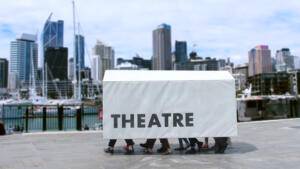
The Drifting Room in Tāmaki Makaurau Auckland. Photo courtesy of Stephen Bain.
The Drifting Room is the final iteration in a series of performances created by Stephen Bain “to explore the relationship between the material ‘reality’ of the city, and the imaginative ‘fiction’ that we layer onto it.”[4] These include Baby, Where are the Fine Things You Promised Me? (2007-11), in which Stephen interacts with passers-by from inside a small model of a New Zealand colonial villa, and The Floating Theatre (2017-23), an intimate performance venue that literally floats in a lagoon. Stephen explains his inspiration for creating The Drifting Room:
“Around 2020 I became interested in Psychogeography experiments first introduced by the Situation Internationalists back in the 1950s and continuing into the present in a more mainstream way by artists and urbanists. I participated in a Drift Club session in Berlin around that time, they are a group of artists who organize walks through the city with no destination in mind, it was such a memorable and surprising way to experience the urban environment. Drift Club shares their processes through Creative Commons networks, so I was able to organize my own drifts around Tāmaki Makaurau, we wandered through familiar locations like Eden Terrace and further afield to new developments like Hobsonville where drifting revealed places and things I never knew existed. It’s also a mildly subversive act because it rejects the official logic of the city by forefronting inquisitiveness. The Drifting Room is essentially my version of the Drift, augmented with a design structure that is a familiar house shape. The building adds a new layer to the experience by announcing itself to the public as both ‘reality’ and ‘fiction’ simultaneously. We walk around as a group enjoying a lesser visible version of the city while becoming a ‘performance’ at the same time. It never fails to surprise me how it works. Perhaps that’s its success as an artwork when it opens a third space between public and private. For participants it’s an imaginative journey that also takes physical effort: the polar opposite of being a passive theatre audience sitting in the dark while the actors do everything for you. Many participants want to become public after they have finished the walk to see what it looks like as an object of performance, while people on the outside often ask how they can become a participant. That’s the best reaction I can hope for, seeing that relationship as something fluid and interchangeable.” [5]
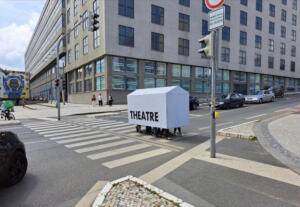
The Drifting Room at PQ23. Prague Quadrennial, Czech Republic 2023. Photo courtesy of Stephen Bain.
The Drifting Room has been performed in five cities to date. It premiered at The Audio Foundation Sound Art Festival in Tāmaki Makaurau (Auckland) in 2020, and since then has been performed at the Hamilton Gardens Festival, Auckland’s Urban Walking Festival, and Whangarei Fringe Festival. In 2023 The Drifting Room was invited to the Prague Quadrennial as part of the Performance Space Exhibition. While performing in the context of this international festival of performance design and space, Stephen made some adjustments to the work: “I used a lot less language, choosing to experience things more sensitively, which taught me a lot about stepping further away as a ‘performer’ and allowing the experience to emerge as a relationship between the people inside, the environment, and the public outside.”[6]
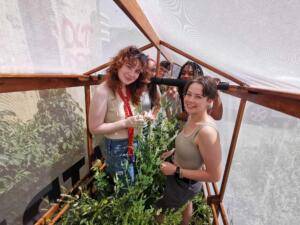
Participants explore urban weeds. The Drifting Room at PQ23. Prague Quadrennial, Czech Republic 2023. Photo courtesy of Stephen Bain.
Stephen has found a multitude of different responses from participants: “like the moment participants suggest we enter into a shopping centre, or infiltrate private spaces. One time on Auckland Waterfront we entered a hotel valet parking and were met by security guards who felt the need to assert their authority, so we just stood there as a (temporary) building and didn’t speak. You could see their thought processes going through an awkward shift from feeling that this might be their responsibility, to realising that we were simply part of the urban environment seeping into private space in much the same way that private spaces seep into public spaces. Aotearoa is a model neoliberal society in many ways: this slippage between private and public is symptomatic of a very conscious process of gifting public space to private individuals and corporations in the hope that they will achieve the same social benefits. Sometimes it works, sometimes it doesn’t. Security guards everywhere (from malls to hotels to Social Services offices) represent that architectural conundrum in practice.”[7]
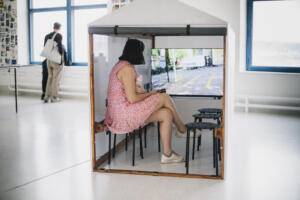
The Drifting Room installation presentation at PQ23. Prague Quadrennial, Czech Republic 2023. Photo courtesy of Stephen Bain.
Stephen finds performing in Wellington has unique challenges because of the “Wind. Wind. Wind. I’ve done many performances in Wellington and always there is a battle with the elements in keeping yourself attached to the ground.”[8] I was lucky to experience The Drifting Room on a windless day, but I speculate that if we’d had to struggle with the elements, this could have added extra symbolic dimensions to the experience. For me, The Performance Arcade was the perfect context for The Drifting Room because, like the art installations in the shipping containers, it was fluid, temporary, and playfully subverted the authority of galleries, theatres, and museums. Stephen found presenting the show at The Performance Arcade interesting because the performances “started on the very public waterfront space where public art is a familiar sight, then slowly infiltrated the city where people are going about their daily lives. At one point, we headed into a dark alley where restaurant workers sat smoking cigarettes, so you got to see how one’s environment shifts our perception of access and ownership.”[9]
By coincidence, when I experienced The Drifting Room, I was reading Rebecca Solnit’s Wanderlust: A History of Walking. Solnit writes, “Walking as art calls attention to the simplest aspects of the act: … the way urban walking elicits unpredictable social encounters…. The way one person’s act can be an invitation to another’s imagination, the way every gesture can be imagined as a brief and invisible sculpture …”[10] The Drifting Room realizes all of this improvisational potential and possibility of viewing public spaces as art, but it does more by doing it in a group. Though our walk is undoubtedly urban it is bookended by the natural backdrop of the magnificent harbour. The name of the show tells us we are not artists or audience but “drifters”. We drift between realities as we drift between spaces. When the theatre rests and we go into stealth mode, we incorporate other spaces and objects into our symbolic space. Because the space is so intimate and so constricted, and it’s necessary for us to cooperate and collaborate, by the final dance we’ve become an effective chorus, moving almost perfectly in sync. As we emerge from the tiny theatre everyone is buzzing with excitement and chatting animatedly about their experiences. On our 40-minute collective flânerie, we have been both audience and performers, we have experienced the city as dramaturgy. In the course of each day of this festival, a few hundred random citizens and visitors have had the pleasure from watching “the theatre”, even if for only a few moments.
[1] See Stephen Bain’s website http://stephenbain.co.nz
[2] See https://www.theperformancearcade.com
[3] A large flightless bird native to Aotearoa, now extinct.
[4] Email from Stephen Bain, 29 February 2024.
[5] Email from Stephen Bain, 29 February 2024.
[6] Email from Stephen Bain, 29 February 2024.
[7] Email from Stephen Bain, 29 February 2024.
[8] Email from Stephen Bain, 29 February 2024.
[9] Email from Stephen Bain, 29 February 2024.
[10] Rebecca Solnit. Wanderlust: A History of Walking. London: Granta, 2022, 276.
This post was written by the author in their personal capacity.The opinions expressed in this article are the author’s own and do not reflect the view of The Theatre Times, their staff or collaborators.
This post was written by David O'Donnell.
The views expressed here belong to the author and do not necessarily reflect our views and opinions.

